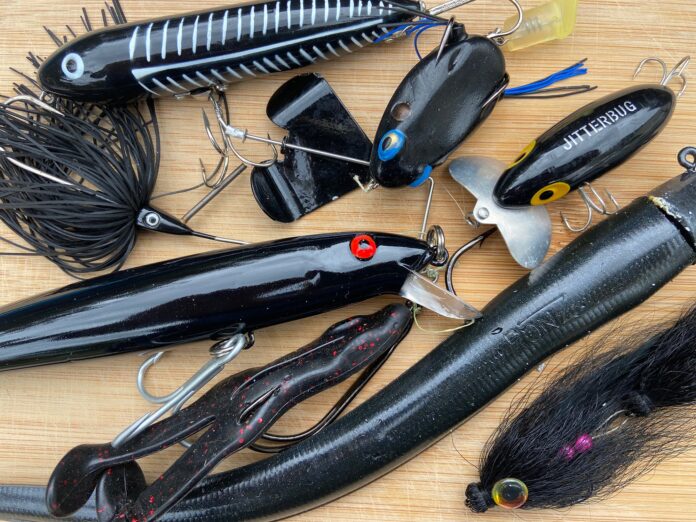One of the oldest cliches in fishing is that lures and flies have to catch fishermen before they catch fish. It is, however, an extremely accurate cliché. Once you take those crankbaits to the register, the company that made them won, whether you catch anything with them or not. This is why lure makers are constantly developing new baits and re-skinning old lures with modern holographic inserts, glow-in-the-dark stripes, flash-foil scales, realistic eyes, and limited-edition paint jobs. We shop for lures and flies with our eyes, just like we shop for shoes and clothes. But sometimes to look the sharpest, all you need is a fresh pair of black wingtips and a tailored black suit.
Black lures, of course, are boring. The color’s sex appeal on the tackle shop shelf is nil. But if you pay attention, even though the loud, flashy version of any given lure or fly might be conveniently at eye level on the pegboard, there’s usually an all-black model quietly hanging out nearby. Black is, after all, one of the top fish-producing colors across practically every fishery—in fresh and saltwater—the world over. For some anglers, beginners especially, that’s a hard fact to wrap their heads around, but once you understand the science behind it, your Bass Pro Shops basket will start getting much, much darker.
The Shape of Things
Let’s say you’re in the mood for a cheeseburger and someone puts two in front of you. You’ll study each one. Maybe the bun of the left burger looks soggier than the one on the right. Maybe the tomatoes on one look juicier than the other or the patty looks like its cooked more to your liking. Predator fish in feeding mode, of course, don’t think like this. The key qualifier if a fish is in the mood for a “burger” is: Does the thing in front of me match the shape and profile of a burger? If yes, it gets chomped. Long before a fish ever gets close enough to a meal to see the scale detail or fin structure, it’s committed to eating it because the shape, size, and movement convinced the fish this is desired prey. Once you consider the importance of shape and size above color, the power of black lures and flies is unlocked.
Everything underwater is backlit. Even at night, any light is coming from above. To create a silhouette in a photograph, your subject—be it bouquet of flowers or can of tomato soup—needs to be in front of the light source, and the darker in color that subject is, the clearer, crisper, and more defined its silhouette will appear. When you apply this to fishing, you start to see how in low light or stained water (or in the middle of a blue bird day, for that matter), a fish can actually see a black lure more clearly and from farther away than a light lure with that ultra-realistic shad pattern. (This is also why the pros so often use black lures when fishing at night). Does this mean the shad pattern is a bad choice and won’t get hit? No, nor does it mean the black lure is guaranteed to get hammered. You must look at black as providing a subtle advantage that, in certain scenarios, can make not-so-subtle differences.
In the striper and snook scenes, black plugs are go-tos for night fishing. In trout fishing, black streamers often get it done better than any other color when the water is stained or murky. In bass fishing, black buzzbaits, Jitterbugs, and frogs shine on bright days when the fish are looking up for a meal. Whether there is or is not abundant natural black forage in the waters where these fish live is irrelevant. All that matters is that black creates a more clearly defined silhouette of the forage that the fish are eating.
READ NEXT: Best Bass Lures
Bugging Out
If I’m flyfishing for smallmouth bass, regardless of the weather and water conditions, I tie on a black popper first. That’s partially because I know that fly will create a sharper silhouette from below, but also because of the bug factor. Leeches, hellgrammites, and stoneflies are common aquatic forage for many different species, and they’re all black. But so are beetles, ants, cicadas, spiders, and many other terrestrial insects that routinely end up in the water. Any time you’re targeting a species that devotes a lot of its calorie budget to insects, black is never a bad choice.
In the case of bug eaters, black comes in handy when you don’t know exactly what the fish are eating, because you can assume that even if they’re keyed into a specific forage, they recognize black foods from eating them in the past. Fly anglers usually have a healthy dose of black patterns available, but if you’re a conventional angler, the same theory applies.
If you’re not sure which color tube or Senko or creature bait to throw first, start with black. If you’re in the mood for some topwater action and see dragon flies zipping around, throw black. Over the years, I’ve been in enough scenarios where I was confident that black would increase the productivity of whatever lure or fly I was using, so I carry a Sharpie for fast-and-dirty darkening. So, if you’re not sold on ponying up cash for boring black lures yet, invest in a marker and try giving one of your favorite lures a custom paint job. Custom paint jobs are all the rage nowadays anyway, so you’ll be right on trend.
Credit: Source link






























